-
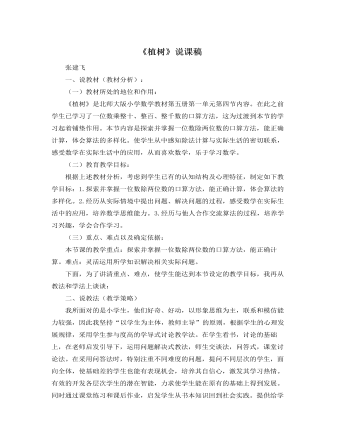
北师大版小学数学三年级上册《植树》说课稿
第一题:分一分,算一算,你是怎样想的,这题进一步巩固了本堂课的知识。第二题:这道题有利于学生学习知识观念的形成,不仅培养了学生解决问题的能力,而且还有利于学生数学思想和方法的形成。第三题:赛跑这道题解决了学生先前遇到的问题,起到了前后呼应的作用,使学生了解到掌握知识是解决问题的有效途径。第五环节:(课堂小结)这一环节我采用提问的方式引导学生总结,我将提出三个问题:1.这节课我们学习了什么?2.你有什么收获?3.你还有什么问题要问?通过全课总结,使学生对自己的学习过程、方法、成果等进行反思和评价,随着对自己的评价,培养了学生自我激励的意识,也推动学习向更高的层次发展。最后说说板书设计,我的板书设计主要是体现出知识的探究过程,帮助学生回顾知识学习的过程,便于学生记忆。
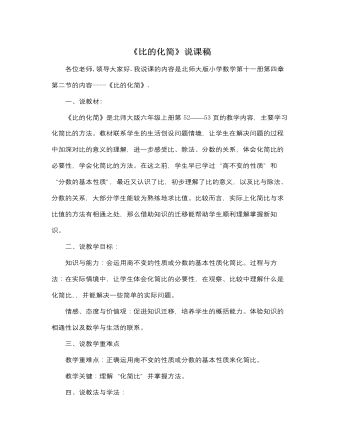
北师大版小学数学六年级上册《比的化简》说课稿
《比的化简》是北师大版六年级上册第52——53页的教学内容,主要学习化简比的方法。教材联系学生的生活创设问题情境,让学生在解决问题的过程中加深对比的意义的理解,进一步感受比、除法、分数的关系,体会化简比的必要性,学会化简比的方法。在这之前,学生早已学过“商不变的性质”和“分数的基本性质”,最近又认识了比,初步理解了比的意义,以及比与除法、分数的关系,大部分学生能较为熟练地求比值。比较而言,实际上化简比与求比值的方法有相通之处,那么借助知识的迁移能帮助学生顺利理解掌握新知识。二、说教学目标:知识与能力:会运用商不变的性质或分数的基本性质化简比。过程与方法:在实际情境中,让学生体会化简比的必要性,在观察、比较中理解什么是化简比,,并能解决一些简单的实际问题。情感、态度与价值观:促进知识迁移,培养学生的概括能力。体验知识的相通性以及数学与生活的联系。
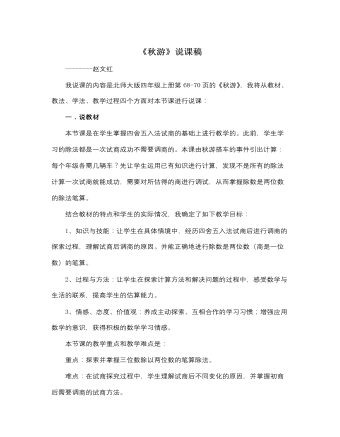
北师大版小学数学四年级上册《秋游》说课稿
我说课的内容是北师大版四年级上册第68-70页的《秋游》,我将从教材、教法、学法、教学过程四个方面对本节课进行说课:一.说教材本节课是在学生掌握四舍五入法试商的基础上进行教学的。此前,学生学习的除法都是一次试商成功不需要调商的。本课由秋游搭车的事件引出计算:每个年级各需几辆车?先让学生运用已有知识进行计算,发现不是所有的除法计算一次试商就能成功,需要对所估得的商进行调试,从而掌握除数是两位数的除法笔算。结合教材的特点和学生的实际情况,我确定了如下教学目标:1、知识与技能:让学生在具体情境中,经历四舍五入法试商后进行调商的探索过程,理解试商后调商的原因。并能正确地进行除数是两位数(商是一位数)的笔算。2、过程与方法:让学生在探索计算方法和解决问题的过程中,感受数学与生活的联系,提高学生的估算能力。

北师大版小学数学四年级下册《蚕丝》说课稿
三、说教学重点、难点重点是小数乘法的竖式计算方法和积与乘数的大小关系。难点是小数乘法中乘数末位有0的计算。四、说学情在进行本节内容学习之前,学生已经学习了整数乘法的运算规律,小数的意义及其加减法,还有小数乘法的计算规律。本节内容重点是学会把小数乘法的运算方法应用到解决实际问题中去。根据四年级学生的认知特点和课堂注意力时间有限的特点,在教学中一定要提高课堂效率五、说教法、学法在本课教学中,我采取的教学方法是:1.通过复习,回顾计算规律,并把它应用到竖式中去。2.情境展示,把数学问题直接放在实际问题中来学习并解决。3.解决问题时采用自主探索、独立思考和小组合作交流的学习方式。通过这些教学法激发学生学习的积极性和主动性,引导学生把学到的规律应用到现实生活中来解决实际问题。六、说教学过程(一)举例说明积的小数位数与乘数小数位数的关系。通过比眼力,做一做,复习前一节课所学内容,为本节课打下基础。
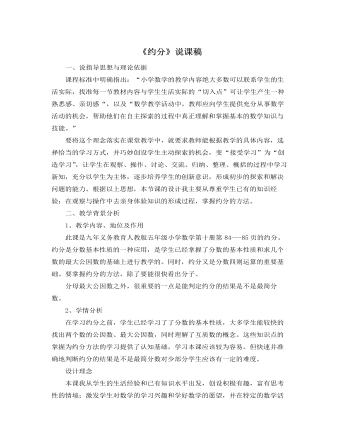
北师大版小学数学五年级上册《约分》说课稿
课程标准中明确指出:“小学数学的教学内容绝大多数可以联系学生的生活实际,找准每一节教材内容与学生生活实际的“切入点”可让学生产生一种熟悉感、亲切感“,以及“数学教学活动中,教师应向学生提供充分从事数学活动的机会,帮助他们在自主探索的过程中真正理解和掌握基本的数学知识与技能。”要将这个理念落实在课堂教学中,就要求教师能根据教学的具体内容,选择恰当的学习方式,并巧妙创设学生主动探索的机会,变“接受学习”为“创造学习”,让学生在观察、操作、讨论、交流、归纳、整理、概括的过程中学习新知,充分以学生为主体,逐步培养学生的创新意识,形成初步的探索和解决问题的能力。根据以上思想,本节课的设计我主要从尊重学生已有的知识经验;在观察与操作中去亲身体验知识的形成过程,掌握约分的方法。
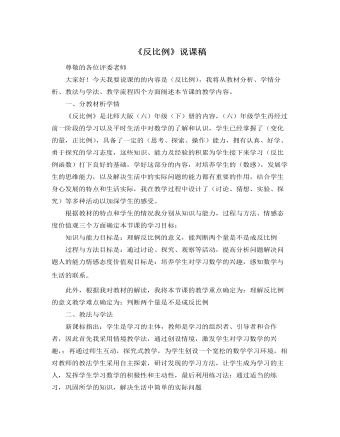
北师大版小学数学六年级下册《反比例》说课稿
知识与能力目标是:理解反比例的意义,能判断两个量是不是成反比例过程与方法目标是:通过讨论、探究、观察等活动,提高分析问题解决问题人的能力情感态度价值观目标是:培养学生对学习数学的兴趣,感知数学与生活的联系。此外,根据我对教材的解读,我将本节课的教学重点确定为:理解反比例的意义教学难点确定为:判断两个量是不是成反比例二、教法与学法新课标指出:学生是学习的主体,教师是学习的组织者、引导者和合作者,因此首先我采用情境教学法,通过创设情境,激发学生对学习数学的兴趣,;再通过师生互动,探究式教学,为学生创设一个宽松的数学学习环境,相对教师的教法学生采用自主探索,研讨发现的学习方法,让学生成为学习的主人,发挥学生学习数学的积极性和主动性,最后利用练习法:通过适当的练习,巩固所学的知识,解决生活中简单的实际问题
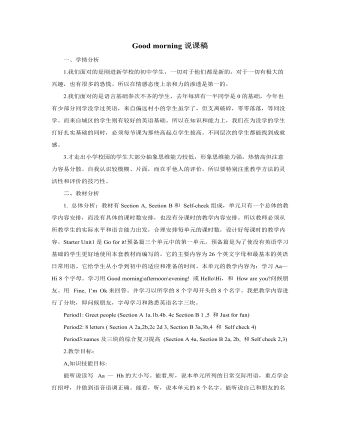
人教版新目标初中英语七年级上册Good morning说课稿
1.课堂活动中的竞赛制:以记奖评优的形式无声的评价每一个活动,包括个体和小群体。在第一课时评最佳演员和导演奖,第二课时评最佳团体奖,既节约时间又明确有效。使学生能提高语言质量,增强参与意识,提高学习兴趣。2. 教师课堂上语言、表情激励制:在课堂活动中教师要乐于 、善于用激励性语言。从good, super, smart, excellent , great ,wonderful等,用微笑,皱眉,摇头、点头等身体语言对于学生的评价是方便又有效的途径。3.课后作业评价:口头作业在第二天课堂上表演,接受全体同学的评价。笔头作业有教师批阅,以评语的方式出现。优秀作业予以展出或交流。积极地肯定和鼓励学生是我们评价的重要目的之一。4.单元结束后综合性评价:除了笔试以外,也可以根据学生实际开展丰富的活动,如:调查报告、小品表演、专题演讲等。

人教版高中英语必修1Journey Down the Mekong说课稿
2. let the Ss complete the forms paragraph by paragraph. Purpose here is to help Ss to get the habit of reading a passage as a whole, and pay attention to the organization of the text, as a result the Ss will fully understand the whole passage.3. ask Ss to retell the passage with the help of the key words in the form.Since the Ss in the class are in different levels, so I let them to fill in the blank to understand the meaning of the words and phrases better. ( That’s all for the while-reading. Now let’s move to the fifth step.)Step V: Post-reading (10mins) ---DiscussionIn this part students are asked to discuss in groups and list Wang Kun’s and Wang Wei’s attitudes about the trip. After that, Ss are encouraged to express their attitudes with the whole class. Collect their answers and don’t forget to praise them even if their answers may not be perfect.In this activity, discussion provides a vivid and active learning environment for Ss to communicate in English with newly learned language items. (Finally it comes to the homework.)StepⅥ: Homework (1min)1. Ss are required to read the text again after class and figure out the meaning of some complex sentences.2. Do the exercises on P19; This can help Ss to consolidate what they’ve learnt and make preparation for the next lessonPart4. Blackboard design.(说板书设计)On the top, there is the title of this lesson. On the left, there are main ideas for each paragraph. On the right, there are some new words and expressions.Unit 3 Travel journalJourney down the MekongMain idea of each para.:Para1: deciding to take a great bike trip along the Mekong river.Para2: Different attitudes between Wang kun and Wang wei.

人教版高中英语必修1English around the world说课稿
(3)v. 给:提出;展现,显现present sb. with sth. ; present sth. to sb. 把. . 交给;颁发;授予present sth. (for sth. )/present sth. to sb. e. g. Om his birthday, his friends presented him a collection of stamps. 在他生日时,他的朋友们送给他一套邮票作为礼物。The sword was presented by the family to the museum. 这家人把宝剑捐赠给了博物馆。The committee will present the final report to Parliament in June. 委员会将在六月向议会提交最后的报告。You need to present yourself better. 你需要更善于展现自己。It is essential that we present a united front. 至关重要的是我们要表现得更加团结。Step 4 ConsolidationT:Now that we have got a general idea of these words and phrases. Lets make up some sentences using them to master them. Suggested sentences:1. Your duties include typing letters and answering the telephone. 2. It is one of the greatest roles that she has played. 3. A large number of people have applied for the job. 4. The number of the panda is declining. 5. I'11 go there, even if I have to walk. 6. He came up to me to ask for a light. 7. The novel is about a family who can't communicate with each other. 8. He based his plan on interests of most people. 9. Why doesn't he make use of his singing talent?Step 5 Summary and homeworkT:Today we dealt with several new words and phrases. After class I hope that youcan read them again and again to keep them in mind. That's all for today. You aredismissed.

人教版高中英语必修3Astronomy the science of the stars说课稿3篇
Step 2 Pre-listeningAfter students finish their discussion, I will show a picture of Newton and ask them: Who is him? What is he famous for? Could you find out some words to describe him? Maybe students will answer that he is genius for his finding of theGravitation, making a great contribution to the progress of human being. At that time I will show another two pictures of Einstein and Hawking, letting students guess who they are and write down their idea about the Gravitation. For I have arranged them to search more information about the gravity before this class, Students have beenfamiliar with the topic and will not be afraid about this abstract conception, which is helpful for their listening.Step 3 While-listeningIn this step, students will be required to listen the material for three times. The first and listening is extensive listening and the second and third listening is intensive listening. In the first time, They are required to listen a material including Part 1 and Part 2 and choose the best summary of the listening text. After they choose the right answer, They also need work in group to explain what is wrong with the others. Then I will make a conclusion that we should pay attention to the first paragraph and last paragraph and some keys to get the main idea. By doing this, their capacity of generalization will have a great improvement.Before the second listening, I will ask students to scan the blank on the power point quickly and ask them to note down some key words .Then ask them to listen to the Part 1again and fill the first column of the chart. Maybe some students just show the ideas of these three scientists an still can’t catch their development of gravity. Therefore, I will ask them to listen to Part 2 again and fill in the rest. After finish the listening, I will give them ten minutes to discuss with their partner. I will also guidethem to improve their answers when they discuss with others.

人教版高中英语必修3Canada-the true north说课稿4篇
Good afternoon, teachers, It’s my great pleasure to be here sharing my lesson with you.The content of my lesson is Senior English Book 3 Unit 5 Canada —— “The true North”.I’ll be ready to begin this lesson from five parts. Analysis of the teaching material,the teaching methods,the studying methods, the teaching procedure,and Blackboard design.First, let me talk about the teaching material.Part 1 Teaching Material:This unit is about the introduction of Canada. By studying of this unit,we’ll enable the students to learn the geography, population, main cities, and natural beauty, natural resources of Canada. Through the training of the unit, it also requires students to learn some Language skills such as the expressions of position and emotions.So it plays an important part in the English teaching in this book.After studying the teaching material and analyzing the rule of children’s growing of mind,I think the teaching aims are the followings:1.Knowledge objects:(1) make the students learn some new words and phrases(2) make the students understand the content of the lesson.2.Ability objects:(1)To develop the Ss’ abilities of listening, speaking, reading and writing. Especially reading and speaking ability.(2) learn to talk about the characters of Canada in English(3)To train the Ss’ ability of working in pairs.3.Emotion objects:(1)Enable students to understand the characters of Canada..(2)Stimulate Ss to work hard to make China stronger.Part 2 Teaching Methods:I think helping students learn to master new words and phrases and improve the students’ reading and speaking ability is import and the difficult.According to the analysis of the teaching material and the import points and the difficult points,I will use the following teaching methods : question-guiding approach; fast-reading and careful reading; multi-media teaching methods; discussion

人教版高中英语必修4Theme parks说课稿3篇
The oldest and the most popular park in the worldenjoy the exciting activities thereget close to the life-size cartoon characters like Mickey Mouse and Donald Duck Step 3 Pre-reading1.What do you suppose a theme park is ?2.What do you think you can see in a theme park?(1.It is a kind of amusement park which has a certain theme – that the whole park is based on. 2.buildings, castles, statues, rare animals and birds, and so on.) Step 4 Reading ----- Theme Parks –---- Fun and More Than Fun1.Predict : Read the title and the pictures on P. 34 and PredictWhat is the meaning of the title “Theme Park – Fun and more than fun”?(The title means that theme parks are fun to visit, but that they can also be educational and can offer useful information.)2.Skimming Fast read and answer:What activities can we take in a theme park?Amusement park: Bumper car Merry-go-round slide bungee jumping Free-fall rides Horror films Pirate ship Ferris wheel roller coaster3.Scanning Read again and you will find various theme parks are mentioned in the passage . Then what are they ?Theme parks: Sports theme park History theme park Culture theme park Marine or Ocean theme Park Future park Science theme park Disneyland4.Careful reading and find the main idea of each paragraph:THEME PARKS---- entertaining/ educationalPara.1 Traditional parks are places to go for relaxation and to have time away from our busy lives.Para.2 Theme parks are different They’re large and full of things to do, see and buy.Para.3 Theme parks are built around a single idea or theme. One example is a sports park.Para.4 Another kind of theme park is historical more and cultural and can be educational.Para.5 Disneylandwas the first theme park. It is based on the fantasy life and characters of Disney’s films.Para.6 Some examples of educational theme parks include sea world parks and science parks.

人教版高中英语必修3The million pound bank note说课稿3篇
在接下来的细读环节,我套用了高考对阅读理解的考查方式设置了5个问题,分别为三个推理判断题,一个细节题和一个主旨大意题。学生需要对文章的内容进行分析、归纳、推理、猜测等高级思维活动才能做出正确的回答。【设计意图】这一过程是对学生进行细读的训练,培养学生获取特定信息和挖掘文章深层次信息的能力。第三环节:Intensive-reading (精读) 15′第三个环节精读,既是最重要的环节,也是突破本课重难点的关键。首先,让学生思考剧本中人物看到百万英镑前后的态度发生了怎样的变化。其次,让学生仔细阅读文章,找出可以表现人物态度变化的具体的语言和动作。最后,让学生总结人物的态度发生变化的根本原因是什么,从而引出Money Talks, 供学生思考。【设计意图】通过一系列的活动培养学生学习从人物的语言和动作探究人物的心理,使学生进一步体会戏剧语言的魅力,从而对文章背后所反映的社会问题进行思考,也为下一步的讨论环节做好铺垫。

人教版高中英语必修5Life in the Future说课稿5篇
Good afternoon, everyone. It’s my great pleasure to be here sharing my lesson with you. The content of my lesson is Senior English for China Book5 Unit 3 Life in the Future. I’ll be ready to begin this lesson from six parts: Analysis of the teaching material, Analysis of the students, Teaching aims and important and difficult points, Teaching methods and aids, Teaching procedures, and Blackboard design. First, let me talk about the teaching material.Part 1 Analysis of the Teaching Material:This unit is about what human beings’ life will be like in about one thousand years. By studying of this unit, we’ll Enable the students to know the changes in humans’ life and some new inventions bringing about the change and develop the interest in science. This lesson plays an important part in the English teaching in this unit. This is an important lesson in Book Five. From this lesson, it starts asking the Ss to grasp contents of each passage. Therefore, this lesson is in the important position of the teaching material. If the Ss can learn it well, it will be helpful to make the Ss learn the rest of this unit.Part 2 Analysis of the SsAs Senior2 Ss, they are at different levels of English fluency, some of them have lost interest in English. So during the lesson, I arrange a variety of activities to let all of them join in to attract their interest and let them be confident and taste the joy of success.
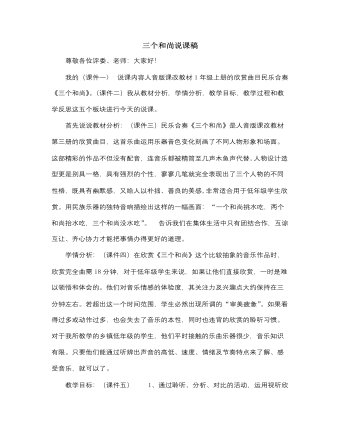
人音版小学音乐一年级上三个和尚说课稿
3.请几组同学表演这几个的场面,其他同学做评委,从模仿表演中享受学习音乐的快乐。五.课堂小结 (阶段目标:以“我的收获”(课件十)帮助学生总结所学内容,知道音乐中,不同的音乐要素可以表现不同的人物、场面)课后反思:(课件十一)在本节音乐欣赏教学中,我坚持以“听”为核心(因为音乐是一门听觉艺术),让学生“带着问题听”、“想着听”、“动着听”、“演着听”等多元化的“听”的形式。一系列“听”的任务不仅提高学生的注意力,而且提高学生“听”的兴趣与“听”的质量。而且我创造和谐的课堂气氛,积极引导学生把对音乐的内心感受大胆地用语言表达出来,让学生主动参与音乐快乐学习的实践中去,创建出有利于学生发展的生动活泼的音乐课堂情景,让学生的了解音乐,感受音乐,融入音乐。
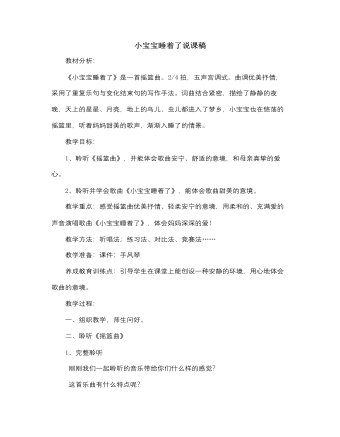
人音版小学音乐一年级下小宝宝睡着了说课稿
三、聆听、表演《小宝宝睡着了》 1、聆听歌曲启发学生说说听到歌曲时感受到了什么?2、复听,跟着歌曲,轻柔地拍节拍。 3、听琴声逐句学唱歌曲。 4、指导学生用连贯、轻柔的声音,唱准、唱好歌曲。 5、重点引导学生说说结尾的处理方式——对比练习,看哪一种方法更恰当 6、引导学生用自己创作的方式为歌曲伴奏、伴舞。 四、小结。 教学反思:一年级课堂上会有一些学生在上课的时候出现喊唱的现象,我在歌曲处理这一环节对歌曲的意境作了这样的描述:静静的夜晚,天上的星星睡了、月亮睡了、地上的鸟儿、虫儿也都进入了梦乡,小宝宝也在悠荡的摇篮里,听着妈妈甜美的歌声,渐渐入睡了。同学们妈妈哄宝宝睡觉唱歌的声音应该是欢快的,还是轻柔的?经过我的描绘和讲解学生理解了在演唱摇篮曲时应该用轻柔的声音,要把每一句都连贯的唱起来,不仅句与句之间要连贯,第一、第二段也要衔接紧凑,轻轻的哼唱出来,体会妈妈哄小宝宝睡觉时是多么的温柔。
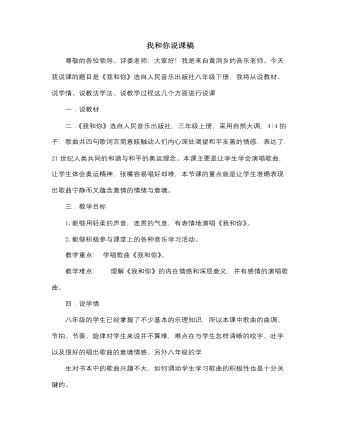
人音版小学音乐三年级上册我和你说课稿
6.欣赏第二版本。 师:关于歌曲《我和你》,还有一个鲜为人知的小故事,歌曲的原唱其实另有他人。最初作曲家陈其钢选了非常有实力的两位歌坛新秀来演唱,导演张艺谋认为一定要选择知名度很高的歌手,两人还因此大吵了一架,据说原唱的歌声更加轻盈,更加动听,你们想听一听吗?7.演唱常石磊版。 师:大家知道了,为了更好地表现出这首歌的宁静简单的气质,我们的演唱要最大限度地轻盈、柔和,就像天使的声音一样纯净。下面该轮到同学们来演唱了。注意眼睛看老师的手势,控制好气息,有表情地演唱。8.钢琴伴奏演唱。师:通过演唱,同学们肯定都感受到了这首歌曲的动人之处。下面我想请同学们站起来,想象我们来到宽敞的户外,把心放在天地间,让我们跟着钢琴伴奏,用我们纯净美妙的歌声来演绎。
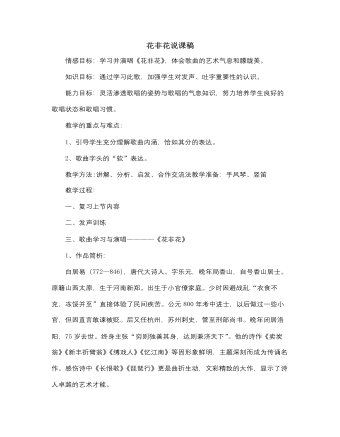
人音版小学音乐六年级下册花非花说课稿
朗读后,可请学生谈谈自己对这首诗的理解。教师还可抓住歌词中“花非花”、“ 雾非雾”和“夜半来、天明去”启发学生理解诗词所比喻的短暂易逝,难持长久的含义。5.有情感地吟诵歌词,体会词曲音调的紧密结合。可先请学生根据诗中每个字的声调,适当地放慢速度、延长韵母来吟诵,然后请一组同学吟诵一句歌词,一组同学哼唱一句旋律,其他同学对照。感知词的声调和旋律的音调之间的联系。6.学唱歌曲,表现歌曲的意境。在学唱时,教师要注意引导学生用轻柔、优美的声音来演唱。每个字的字头可唱得稍为、虚幻而柔美些,体现、朦胧诗的意境,唱好歌中的力度变化。注意气息的运用,尤其是最后一句“去似朝云无觅处”的渐慢与渐弱的处理,气息要控制好。四、拓展根据教学提示的要求,复习和交流学生已掌握的有关诗词歌曲,可以个人或设计小组演唱等多种表演形式,与同伴分享和分组展示。
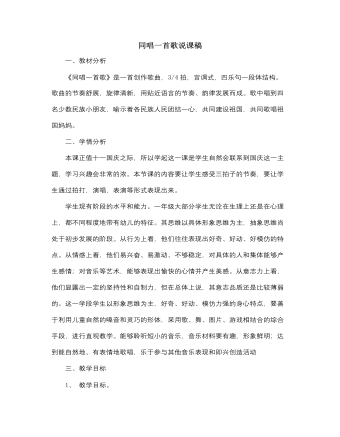
人音版小学音乐一年级上同唱一首歌说课稿
(7) 跟老师按节奏朗读歌词(8) 轻声的和老师齐唱一遍。(老师大声学生小声)(9) 听琴慢速唱一遍,及时解决问题。(解决难点休止符)(10) 听范唱找一找歌唱的感觉。(11) 跟范唱演唱。(12) 歌曲处理:跟着少数民族的孩子一起载歌载舞的表演,边表演边带出演唱的感觉。3、 拓展:将自己的名字加在歌曲中与少数民族的孩子一起表演。全班分为六组,讨论歌曲第一句的创编,可以是同学的名字,也可以是朋友、家人的名字。分组展示本组的编创成果,歌唱时合着音乐的节拍表演。四、 教师总结1、 师:同学们今天我们一起感受了音乐带给我们的快乐,体会了祖国大团结给我们带来的喜悦,我想同学们一定能将这喜悦之情蔓延出去,同时也期待着大家更加喜欢音乐,在音乐学习中有更多的收获。
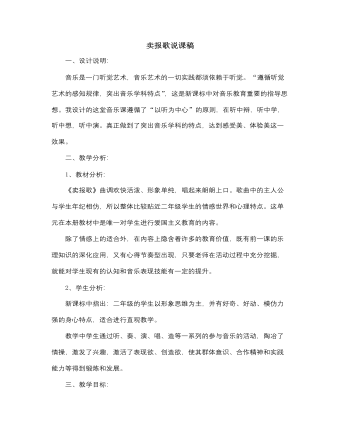
人音版小学音乐二年级下册卖报歌说课稿
3、分组表演,进行评价,改进提高。说明:新课标中鼓励音乐创造,注重个性发展,教师应为学生提供发展个性的可能和空间。本节课安排了歌曲表演创作的环节,分三段,以小组的形式讨论,创设“小毛头”当时卖报的情景,表现“小毛头”的心情。这一环节的设计重在启发学生展开音乐想象,在课堂上大胆说、大胆想、大胆创造、大胆唱、大胆演,鼓励在音乐体验中的独立见解。这个环节还可以锻炼学生的动作协调能力。(五)教学评价生生互评,师生共评的评价过程,能使学生达到感受自我,正确评价自我的目的。教学预设:本节课的设计中,我依据学生的年龄特点,采用了多种教学方法。每个知识点的出现尽量做到自然流畅,难点教学中遵循由浅入深的原则。学生在教师的引导下,或聆听感受,或听辩体验。40分钟的快乐学习,一定会让全体同学都有所收获,那就是能完整准确的演唱歌曲,并且会用动作表现和歌曲情感来进行歌表演。